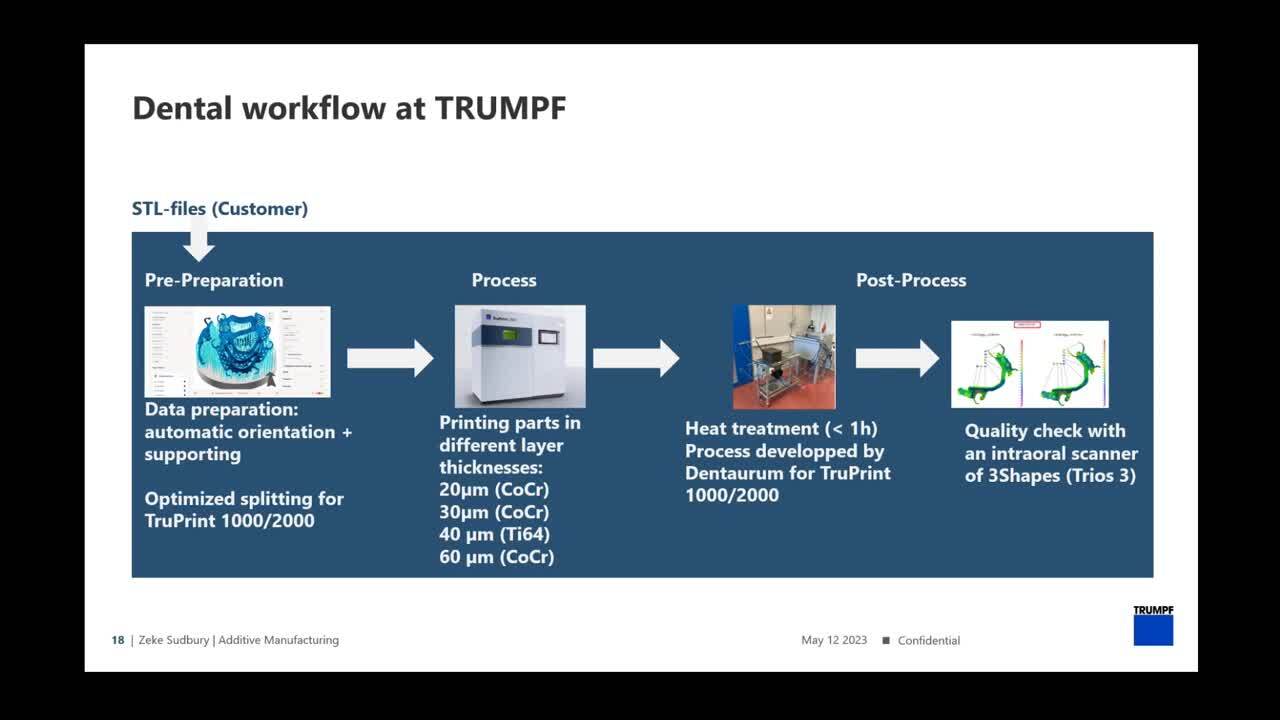Trumpf and Oqton bring a new level of efficiency to metal 3D printing in dentistry
Additive manufacturing has become a mainstay in dental labs. In a recent survey at LMT Lab Day, respondents indicated the vast majority of labs (77%) use 3D printing, with 58% running 3D printers in-house, 12% outsourcing and 7% doing a mix of both. Most of this work is done with polymers (87%), but some are exploring metal additive manufacturing (10%).
Trumpf and Oqton are helping more dental labs leverage this technology. In a recent webinar, the companies discuss how.
The hardware – Trumpf metal 3D printers
Trumpf is a family-owned industrial technology company and a pioneer in additive manufacturing for metal. Its laser powder bed fusion systems — specifically the TruPrint 1000 and TruPrint 2000 — enable dental labs to 3D print RPDs and other products with exceptional speed and cost efficiency.
With Trumpf systems, 3D metal printing takes less than a day, boosting production capacity. The process starts with an impression of the patient’s mouth instead of a traditional waxup. This impression is scanned and then a technician uses dental CAD software to design the RPD frame.
For 3D printing data preparation, Trumpf uses Oqton’s Manufacturing OS because it dramatically shortens the learning curve for technicians by automatically recommending optimal part nesting and tray orientation.
The parts are printed using a laser and a bed of powdered metal. Trumpf’s printers features a glove box so technicians can depowder the printed pieces using a brush without wearing PPE. This can also be done with a vacuum, but this requires open doors and a technician wearing PPE.
Printed products are removed via a cylindrical “coffee maker” apparatus that can be taken to a separate system for sieving, which recaptures any unused powder for recycling. Then the products are heat treated in an argon oven for an hour and briefly finished for the desired surface quality.
The software – Oqton Manufacturing OS for dental production
On the software side, the Oqton Manufacturing OS is an ideal fit for 3D printing in dental labs because it uses artificial intelligence to automate many of the repetitive tasks involved, like labeling parts and determining how to place them on a build plate.
The Manufacturing OS includes a manufacturing execution system (MES) for managing production workflow, an IoT component for machine monitoring, and a CAM component that generates files for printing. At a high level, the MES allows supervisors to digitize production planning, see real-time machine status via video and sensor feeds, and use dashboards and alerts for efficient production monitoring.
All of this happens securely in the cloud to maximize accessibility, scalability and throughput. The AI uses deep learning and neural-guided search to learn how to nest dental products for maximum efficiency and minimal operator intervention, and it adjusts to user preferences over time.
Best of all, Oqton Manufacturing OS is fully integrated with Trumpf 3D metal printers. Oqton parameters are validated by Trumpf, so labs that switch to Oqton can expect an immediate 25% reduction in print time. Oqton can automatically nest on the TruPrint 1000, and it can nest up to 20 RPDs on the TruPrint 2000, cutting production time from more than six hours to just under four.
To learn more about the advantages of Trumpf and Oqton in metal 3D printing for dental labs, watch the full webinar below.

Topics 
Subscribe to our newsletter
Get our best content straight in your inbox

 Marta Matvijev
Marta Matvijev